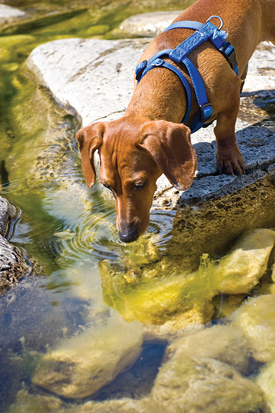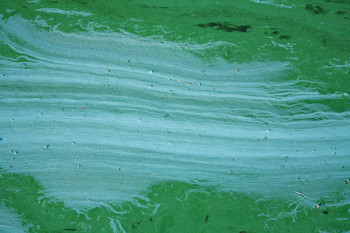The sun is shining, the birds are singing, and your dog is relaxing in the grass after a playful romp in a nearby pond. But after a few minutes, it becomes clear that something is wrong. His exhaustion has turned to disorientation and extreme lethargy. A few minutes later he is overcome by muscle tremors and vomiting. By the time you get him to the car, you realize that he may not make it home alive.
Nightmarish though it may be, this scene plays out each year as dogs are exposed to toxic algae in natural and manmade ponds. It’s vitally important to learn how to keep yourself and pets safe from toxic algae contamination and what to do in case of algal toxin poisoning. Unfortunately, it is impossible to tell visually, by taste or by odor whether a bloom is toxic, so precaution is your best option if you’re near a scummy pond with your dog.
Deadly Blooms
The first recorded episode of animal poisoning attributable to cyanobacteria occurred in

err on the side of caution.
Australia in 1878. Most algae blooms are simple green algae and not harmful to dogs, but some blooms are actually a type of cyanobacteria that have the ability to produce toxins. When this toxic cyanobacteria (aka blue-green algae) is active, scientists and policymakers refer to them as harmful algal blooms (HABs).
What causes HABs and when do they occur? While many factors contribute to HABs forming, the primary reasons include:
- Still or low-flow water
- Warm temperatures
- Abundance of direct sunlight
- Excess nutrients, primarily nitrogen & phosphorus
HABs do occur naturally, but the frequency and severity is heavily influenced by humankind.
In cases when toxin concentrations are unknown, pet owners should err on the side of caution and keep their dogs out of the water when suspicious-looking blooms appear. Only after water samples have been taken and analyzed can we be certain of the presence of toxins.
The blooms typically occur in the late summer and early fall when temperatures are highest and water levels are lowest. HABs are most likely to appear during periods of warm, sunny and calm conditions directly following a rain storm.
As rainwater passes through our storm drains and back into the waterways, it carries sewage and wastewater discharges as well as the residuals from fertilizers, animal manure and failing septic tanks. Add in a sunny day and slow water and you have the perfect recipe for an HAB!
In cases of extreme blooms, local agencies will typically place signs up around the waterway. But you should always check with your local, state and federal agencies for a forecast of HABs and to learn about active blooms to stay away from.
Treating Your Pet
How do you treat a dog who appears ill from blue-green algae toxins? Call the veterinarian immediately! Since death generally follows within days as a result of liver failure, treat every bloom as if it has toxins. Dogs are especially vulnerable to these waters because of their innate behavior to lap around a body of water. They are also attracted to the smell, which makes leashing very important. Hunting dogs are especially predisposed due to increased exposure outdoors.

Unfortunately, there is no antidote for the toxins produced by blue-green algae or cyanobacteria. Call the Pet Poison Helpline (800-213-6680) or the ASPCA (888-426-4435) for immediate help. Consultation fees will apply.
A note to dog owners and parents: When in doubt, stay out! If you see a bad situation on a lake, even if it’s not the obvious pea-soup or paint kind of look, you’re better safe than sorry.
Prevention is Best
A pet is like part of the family…especially a dog. Losing a pet can feel like losing a child or a longtime companion. Keeping pets safe is a priority, so if you live on a big property be careful of where you let your dogs or other pets play. Most importantly, keep your dog leashed while around suspected waters. If you use fertilizers, try to keep the area where they are used contained.
To be safe, only let your dogs or pets drink clean tap water.
If possible, keep your dog on a leash near shorelines. Don’t let dogs wade, drink the water or eat/walk in beach debris. If your dog goes in the water remove them immediately. Don’t let them lick their fur or paws after getting out of the water until you can thoroughly rinse/wash them from a safe freshwater source.
Use a towel or rag to remove algal debris. Use rubber gloves if possible. Remember to wash your own hands with fresh water. Look closely for any symptoms and notify the public health department or state natural resource management agency if you observe a suspected harmful algae bloom.
Animal Symptoms From Harmful Algae Toxins
- Lethargy
- Weakness
- Pale mucous membranes
- Disorientation
- Excessive salivation and tear production
- Muscle tremors
- Seizures
- Respiratory distress
- Vomiting
- Diarrhea
- Bloody, black or tarry stool
- Jaundice
- Shock
- Coma
- Death
Human Precautions for Harmful Algal Blooms
People should wear rubber gloves while bathing their dogs if they suspect contamination.

If you ingest water, fish or blue-green algal products containing elevated levels of toxins, you may experience headaches, fever, diarrhea, abdominal pain, nausea and vomiting.
If you swim in contaminated water, you may get itchy and irritated eyes and skin, as well as other hay-ever-like allergic reactions. If you suspect you might have come into contact with cyanobacterial toxins and are experiencing any of these symptoms, rinse any scum off your body and consult your physician immediately.
FAQs
>> Can I drink the water?
No don’t drink untreated surface water. Boiling the water will also not remove the toxins.
Can I cook with the water?
No do not cook in contaminated water.
>> Can I bathe or swim in the water?
No, avoid contact with contaminated water. The longer people remain in the water the more severe the symptoms.
>> Can I use the water for pets and livestock?
No, pets and livestock should not consume water unsuitable for human consumption.
>> Can I eat fish caught from waters where HABs occur?
No, don’t eat fish as they concentrate toxins. If you live in an area where HABs occur, do not eat shellfish as they can also concentrate toxins from contaminated water sources.
>> What symptoms might I experience if I’ve been in contact with the water?
Skin rash, flu-like symptoms, tingling or numbness of the lips and mouth from within 30 minutes to three hours after exposure. Severe exposures might result in motor weakness, lack of coordination and/or respiratory or muscular paralysis.
>> What if I think I’ve been exposed to algal toxins?
Rinse yourself and/or your pet off after swimming in any ponds, lakes or streams. Get medical treatment right away if you think you, your pet or your livestock might have been poisoned by algal toxins. Remove all other people from exposure.
Toxic algae may not seem like a risk, but its dangerous effects can happen devastatingly quickly. Dog owners report that after playing in and drinking some of the water, strange behavior is exhibited within 45 minutes including lethargy and vomiting, followed shortly by death. To protect your furry friends, check for signs, proceed with caution near polluted water and make sure to inform your friends of this silent killer.

